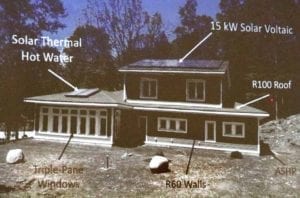170 PARTICIPANTS
HEAR MANY IDEAS
FOR FUEL FUTURE
Chamber’s Rubin: Exciting Information
Exchanged, But ‘Now The Work Begins’

By JIM KEVLIN • Special to www.AllOTSEGO.com


COOPERSTOWN – In the end, 170 – up from 125 a week ago, and 155 a couple of days ago – today listened for eight hours to presentations on the United States’ – and Otsego County’s – energy future from some of the most knowledgeable people in New York State.
The venue was the Otsego County Chamber of Commerce’s “Energy Summit: Energy & The Economy,” which finished up in late afternoon in The Otesaga’s pretty-close-to-full ballroom.
When it was over, Al Rubin, chairman of the chamber’s board, and chamber President Barbara Ann Heegan both said they were pleased by the amount of information the 19 varied presenters delivered in mostly 15-minute segments between 9 a.m. and 5 p.m.
“This wasn’t about debate,” said Rubin. “This was about listening to what other people had to say. This event met and beat our expectations.” But, he added, “The work begins now.”

There is also a formal apparatus to do it: county Rep. Meg Kennedy, C-Mount Vision, who has chaired a county board Leadership Team on energy policy, announced members of an Energy Task Force as today’s Summit began.
At day’s end, the other county rep on the Leadership Team with Kennedy, Michele Farwell, D-Morris, said: “We’re in a period of transition. And we need to be looking toward the future. That’s a question for our committee.”
The day’s “most significant slide,” she said, was in the presentation by Lou Allstadt, the retired Mobil executive vice president, showing renewable costs going down on a graph, crossing another line showing fossil-fuel costs going up. (Another slide showed a similar dynamic in job creation, with renewable jobs outstripping fossil fuels.)
For his part, Allstadt said, “We heard some old ideas that have been around for the past 10 years. But there was a lot of new information about how fast things are changing. A lot of people heard a lot they hadn’t heard before. And that includes me – on all the NYSERDA projects.”
Other highlights of the day included:
• Mark Davies, Hartwick professor and Oneonta Environmental Board chair, discussed “eco-commercial parks” that use renewable energy and green strategies to create jobs. They exist in several states, but “there are no ‘eco-parks’ in New York State,” he said. “That sits out there.”
• State Sen. Jim Seward, R-Milford, expressed support for renewables, but also for access to natural gas that existing companies need now. “We could lose a whole generation of people who will look elsewhere for economic prospects,” he said.

• Tony Ingraffea, the fracking foe and Cornell professor, detailed how, with a geothermal system that extracts heat from air, energy efficiencies and a large stand of Norway firs, he has reduced his family’s “carbon footprint” to “less than zero.” It was minus-6 this morning, but his Ithaca-area home was 72 degrees when he left.
• Otsego Now CEO Jody Zakrevsky reported that lack of gas ruled Otsego County out of the running for a 300-job Chinese company looking to locate a factory upstate, and for a distribution center eyed for Schenevus.
• Karen Bee-Donohoe, SUNY vice chancellor for Capital Investment, reported that SUNY Oneonta has a committee tasked with getting the campus to net-zero energy use.
• Leatherstocking Gas CEO Mike German reported that $10 million in investment had brought leaks in his company’s pipelines down to zero, and that while it is supplying gas to new companies moving into northeast Pennsylvania, a lack of gas had stalled development in New York’s Southern Tier, including Otsego County.
• Further, NYSEG executive Cindy Chadwick reported expanding that company’s 8- and 10-inch gas line from DeRuyter to Otsego County is going forward, but the utility isn’t sure it can get any more gas supply when the job is done.

• The keynoter was Jay Egg of Geothermal, who discussed the wide adoption of geothermal systems from Bard College dorms to New York City skyscapers using heat exchangers, which extract heat from water in the winter and cool air in the summer. He didn’t get into costs, but he suggested Otsego Lake and the Town of Oneonta’s prospective water system in the Southside both offered opportunities for community geothermal systems.

